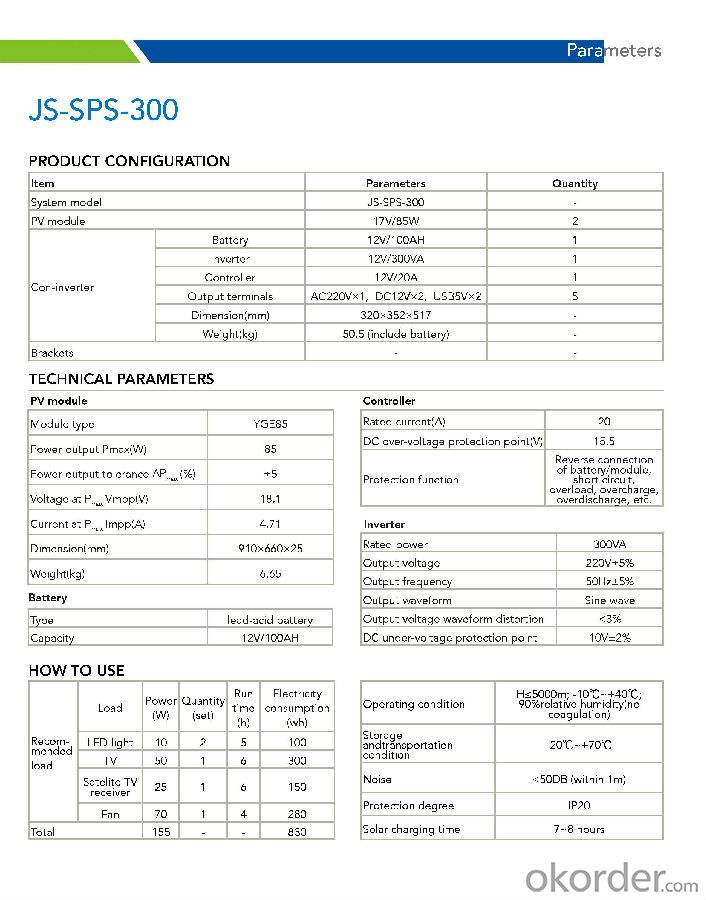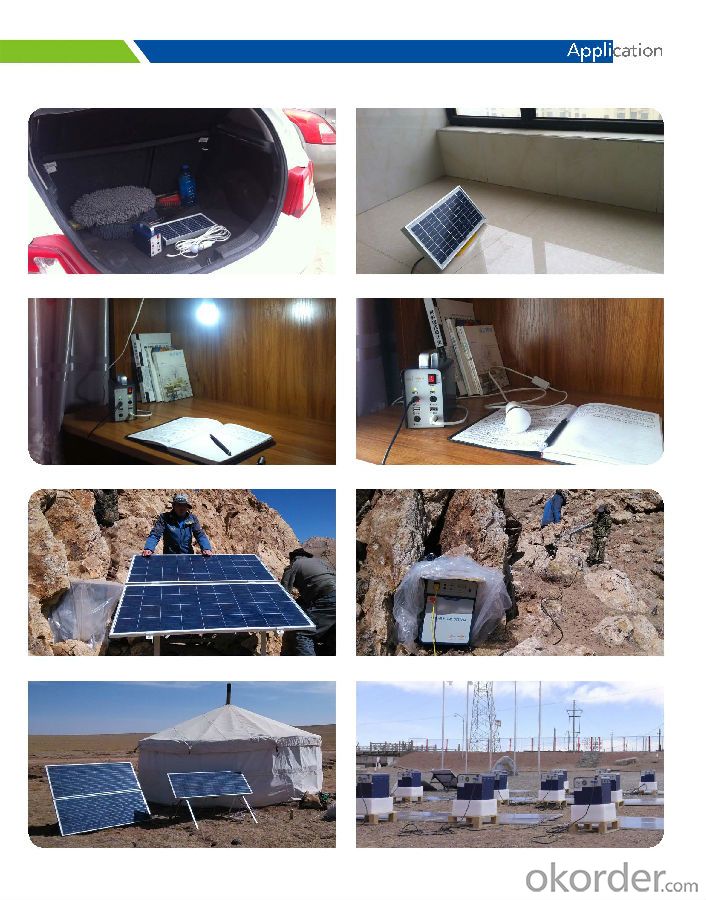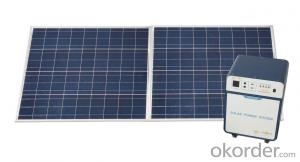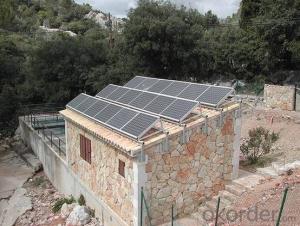Off-grid Solar Power System JS-SPS-300
- Loading Port:
- Tianjin
- Payment Terms:
- TT or LC
- Min Order Qty:
- 10 set
- Supply Capability:
- 10000 set/month
OKorder Service Pledge
OKorder Financial Service
You Might Also Like
General Introduction
Solar power system provides alternating current and direct current, which is produced by the modules transforming solar power into power, to home lighting, household appliance and other DC appliance, such as cell phone and laptop.
Solar power system is widely used in area lack of power, for example house power supplying, monitoring, communication base, fire prevention in forest area, pasture and meadow, aquaculture etc.
We are dedicated to provide high quality off-grid PV products and systems to customers and has received a series of certificate, including ISO9001, TUV, UL, CE, CQC and RoHS.
Off-grid Solar Power System
High efficent PV module can produce more power.
Sine wave output is suitable for all kinds of load. Varieties of DC output, let it more convenient for users.
The multifunction design make it easy to operation and maintenance.
Off-grid Solar Power System Parameters

Off-grid Solar Power System Application

Our Factory

- Q:Can solar energy systems be used in conjunction with backup generators?
- Yes, solar energy systems can be used in conjunction with backup generators. In fact, this combination can provide a more reliable and efficient power supply. Solar energy systems harness energy from the sun and convert it into electricity, which can power homes, businesses, or other facilities. However, solar panels only generate electricity when the sun is shining, so they may not be able to meet the power demands during cloudy days, at night, or during power outages. This is where backup generators come in. A backup generator is a device that can provide electricity when the main power source is unavailable or insufficient, such as during blackouts or when the solar energy system is not producing enough power. By integrating a backup generator with a solar energy system, it ensures a continuous and reliable power supply regardless of weather conditions or grid disruptions. When solar panels are generating excess electricity, they can charge batteries that store the energy for later use. During periods of low solar production or high energy demand, these batteries can be utilized to power the premises, reducing the need for the backup generator. However, in situations where prolonged cloudy days or an extended power outage occurs, the backup generator can kick in and provide the necessary energy to keep the lights on and essential appliances running. This combination of solar energy systems and backup generators offers the benefits of renewable energy and energy independence, while also providing a backup power source when needed. It is especially useful for areas with unreliable grid infrastructure or regions prone to natural disasters. Additionally, this integration allows for better management of energy usage, potentially reducing electricity costs and minimizing fossil fuel consumption.
- Q:What are the environmental benefits of using solar energy systems?
- There are several environmental benefits associated with using solar energy systems. Firstly, solar energy is a renewable source of energy, meaning it is constantly replenished by the sun and will never run out. This is in stark contrast to fossil fuels like coal or oil, which are finite resources and contribute to the depletion of our planet's natural resources. Another significant environmental benefit of solar energy is its minimal greenhouse gas emissions. When compared to traditional energy sources like coal or natural gas, solar energy systems produce significantly lower levels of carbon dioxide and other harmful pollutants. By reducing our reliance on fossil fuels and transitioning to solar power, we can mitigate the adverse effects of climate change and improve air quality. Furthermore, solar energy systems have a smaller ecological footprint compared to other forms of energy generation. The extraction and transportation of fossil fuels often leads to habitat destruction, soil erosion, and water pollution. On the other hand, solar panels have a relatively low impact on the environment during their manufacturing process, and they do not require ongoing extraction or transportation of fuel. Solar energy systems also offer the advantage of decentralization. Unlike large-scale power plants that rely on extensive transmission infrastructure, solar panels can be installed on rooftops, reducing the need for long-distance energy transportation. This not only decreases the energy loss during transmission but also helps to protect natural habitats from being disrupted by the construction of power lines. Finally, using solar energy systems can contribute to energy independence. By harnessing the power of the sun, individuals, communities, and even entire countries can reduce their reliance on imported energy resources. This reduces the vulnerability to price fluctuations and supply disruptions associated with fossil fuels, promoting energy security and stability. In conclusion, the environmental benefits of using solar energy systems are numerous and significant. From being a renewable source of energy and reducing greenhouse gas emissions to minimizing ecological footprints and promoting energy independence, solar power offers a sustainable and responsible alternative to traditional energy sources.
- Q:Are there any government incentives or tax credits for installing a solar energy system?
- Yes, there are government incentives and tax credits available for installing a solar energy system. These incentives and credits vary by country and region, but they often include federal tax credits, state or local rebates, grants, and incentives that aim to promote the adoption of renewable energy sources. It is advisable to research and consult with local authorities or a tax professional to determine the specific incentives and credits available in your area.
- Q:Can solar energy systems be used in all climates?
- Solar energy systems can be used in various climates, but their efficiency and performance may vary. While solar panels can still generate electricity in colder or cloudier climates, their output may be lower compared to sunny regions. However, advancements in technology and the use of more efficient solar panels have made it possible to harness solar energy in a wider range of climates, making it a viable and sustainable option for many locations around the world.
- Q:Are there any risks of electrical hazards during installation or maintenance of solar energy systems?
- Yes, there are risks of electrical hazards during the installation or maintenance of solar energy systems. Solar energy systems involve working with high-voltage DC (direct current) electricity, which can pose dangers if not handled properly. Some of the potential risks include: 1. Electrocution: Solar panels generate electricity, and if not isolated or disconnected properly, there is a risk of electrocution for individuals working on the system. 2. Fire Hazards: Faulty wiring, loose connections, or improper installation can lead to electrical arcs and sparks, which can ignite a fire if proper precautions are not taken. 3. Falls and Injuries: Solar panels are typically installed on rooftops, which may involve climbing ladders, working at heights, and handling heavy equipment. If not done with caution, it can result in slips, falls, or injuries. 4. Arc Flash: When working on live electrical equipment, there is a risk of arc flash, which is a sudden release of energy that can cause severe burns, hearing damage, and even death. 5. Environmental Risks: While not directly related to electrical hazards, it is essential to consider potential environmental risks during the installation of solar energy systems. For instance, improper disposal of hazardous materials used in solar panels, such as lead, cadmium, or other toxic substances, can harm the environment if not handled correctly. To mitigate these risks, it is crucial to follow proper safety protocols and guidelines during the installation and maintenance of solar energy systems. This includes wearing personal protective equipment (PPE), ensuring proper grounding and isolation procedures, using insulated tools, and following all local electrical codes and regulations. It is also recommended to hire trained and certified professionals for the installation and maintenance to minimize the risks associated with electrical hazards.
- Q:Can solar energy systems be used in areas with high levels of bird or wildlife activity?
- Yes, solar energy systems can be used in areas with high levels of bird or wildlife activity. While there may be concerns about potential bird or wildlife interactions, various measures can be implemented to mitigate these risks. These can include using bird-friendly designs for solar panels, such as reducing reflective surfaces or installing netting to deter birds from nesting. Additionally, strategic placement of solar panels away from crucial wildlife habitats and using proper monitoring and maintenance protocols can help ensure the coexistence of solar energy systems and wildlife activity.
- Q:What is the lifespan of solar panels used in solar energy systems?
- The lifespan of solar panels used in solar energy systems can vary, but on average, they are designed to last for about 25 to 30 years.
- Q:Can solar energy systems be used for powering telecommunications towers or antennas?
- Yes, solar energy systems can definitely be used for powering telecommunications towers or antennas. Solar power is a sustainable and reliable source of energy that can be harnessed to provide electricity for various applications, including powering telecommunications infrastructure. Telecommunications towers and antennas require a constant and uninterrupted supply of electricity to function effectively. Traditional methods of powering these towers, such as diesel generators, are not only expensive but also contribute to pollution and carbon emissions. Solar energy systems offer a cleaner and more cost-effective alternative. Solar panels, installed on or around the telecommunications tower, capture sunlight and convert it into electricity through photovoltaic cells. This electricity can either be used directly to power the tower's equipment or stored in batteries for later use during periods of low sunlight. By utilizing solar energy, telecommunication companies can reduce their dependence on fossil fuels and lower their operational costs. Moreover, solar energy systems can be installed in remote locations where it is often challenging to access the grid or establish a reliable power supply. In such cases, solar power can provide a viable solution, allowing telecommunication companies to extend their coverage and connectivity to underserved areas. In conclusion, solar energy systems are an excellent choice for powering telecommunications towers or antennas. They offer a sustainable and cost-effective solution while reducing environmental impact. With advancements in solar technology, the efficiency and reliability of solar power systems continue to improve, making them a viable option for the telecommunications industry.
- Q:Can solar energy systems be used in areas with limited access to cultural resources?
- Yes, solar energy systems can be used in areas with limited access to cultural resources. Solar energy systems are a form of renewable energy that can be harnessed in remote areas without relying on traditional infrastructure or cultural resources. This makes solar energy an ideal solution for providing electricity and powering various applications in areas where cultural resources may be limited or inaccessible.
- Q:Can solar energy systems be used for powering boats?
- Yes, solar energy systems can be used to power boats. Solar panels can be installed on the boat to capture sunlight and convert it into electrical energy, which can then be used to power various systems onboard, including propulsion, lighting, and navigation equipment. This renewable energy source is increasingly being adopted by boat owners as it reduces dependence on fossil fuels, lowers operating costs, and helps to minimize environmental impact.
1. Manufacturer Overview |
|
|---|---|
| Location | |
| Year Established | |
| Annual Output Value | |
| Main Markets | |
| Company Certifications | |
2. Manufacturer Certificates |
|
|---|---|
| a) Certification Name | |
| Range | |
| Reference | |
| Validity Period | |
3. Manufacturer Capability |
|
|---|---|
| a)Trade Capacity | |
| Nearest Port | |
| Export Percentage | |
| No.of Employees in Trade Department | |
| Language Spoken: | |
| b)Factory Information | |
| Factory Size: | |
| No. of Production Lines | |
| Contract Manufacturing | |
| Product Price Range | |
Send your message to us
Off-grid Solar Power System JS-SPS-300
- Loading Port:
- Tianjin
- Payment Terms:
- TT or LC
- Min Order Qty:
- 10 set
- Supply Capability:
- 10000 set/month
OKorder Service Pledge
OKorder Financial Service
Similar products
New products
Hot products
Hot Searches
Related keywords






























